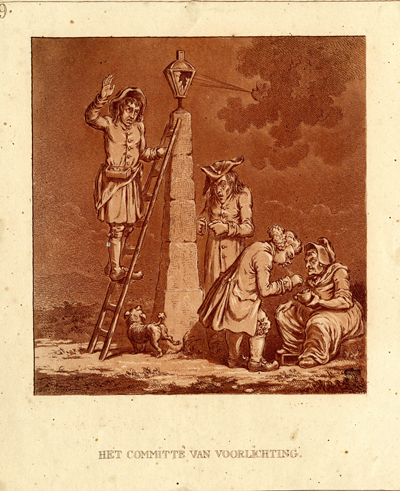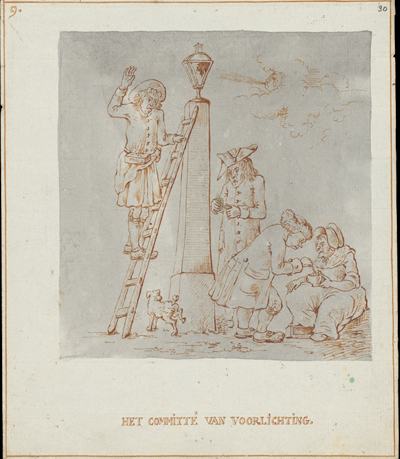Het Committé van Voorlichting
This is the ninth plate of a twenty plate series, Hollandia Regenerata, etched by Gillray based on drawings by the Swiss soldier, painter, and caricaturist, David Hess. For more about David Hess, and the political and artistic context of the series satirizing the newly-created and French-supported Batavian Republic, see my Introduction.
The title can be translated as "The Illumination Committee." According to Joost Rosendaal whose "Nawoord" to his facsimile edition of Hollandia Regenerata is essential reading for anyone interested in the series, this committee was responsible for ensuring "that the people were given the right revolutionary ideas." In practice, he says, this meant supervising the conversion of the local administrators—presumably from Orangists to Patriots with the correct ideas.
But, as the print shows, the process of enlightenment is not easy. A lamplighter stands on a ladder trying to light a lamp atop a stone obelisk. The panes of the lamp are broken, so the wind will extinguish any flame he can create. His companions are having no better luck. One seems to be trying to strike a spark with flint and steel. The other is trying to encourage a flame in a tinder cup. The stray dog at the base of the obelisk provides a final humiliating commentary on their efforts.

Het
Committé van Voorlichting
[1796?]
© Trustees of the British Museum
As with all the plates in the series, the corresponding page to the image contains one or more appropriately ironic Biblical quotations in Dutch and English and a satiric "Explanation" in French. The Biblical quotation suggests a divine explanation for this committee's lack of progress:
job, xviii. 5. "The light of the wicked shall be put out, and the spark of his fire shall not shine."
The "Explanation." suggests that success may simply be out of this committee's control. Here is the French text:
Il est sur que dans une nuit aussi obscure il faudrait un bon reverbère. Ce Committé se donne bien dela peine pour al lumer la grande lanterne. Mais–le vent siffle–les verres sont cassé–comment les raccomoder?–
And here is my free English translation.
He is sure that such a dark night needs a good lamppost. This Committee is taking pains to light the big lamp. But the wind whistles, the glass is broken. How do you fix that?
As Simon Schama explains in his book, Patriots and Liberators, the Patriots, though united in their opposition to the Prince of Orange, were deeply divided in almost everything else. And there was considerable danger that the various provinces, each with its own agenda, would never reach agreement about a plan for unification. Hess's image may be hinting at this lack of concord by showing three sets of separate and ultimately redundant efforts for illumination while darkness falls and the wind increases.

Het
Committé van Voorlichting
[1796?]
© Zentralbibliothek Zürich
Knowing his limitations as an artist, Hess does not appear to have even tried to create the background dusk that we see in the final image. Instead he simply drew his figures on a grey paper that served as a rough indicator for Gillray to enlarge upon. Gillray then used his considerable skills in aquatint to create a wonderful night time background. While he was at it, Gillray also made a number of small changes that heighten the effectiveness of the final print, including the appropriate shading of all the figures, fixing the awkward right arm of the lamplighter, creating visible segments in the obelisk, and adding breath lines to the figure bending over the tinder cup to help us understand what is going on.
Sources and Reading
- Commentary from the British Museum on Het Committé van Voorlichting.
- "Batavian Republic," Wikipedia
- "David Hess (painter)," Wikipedia
- "David Hess," SIKART Dictionary
- David Hess, Hollandia Regenerata (1797), Nawoord by Joost Rosendahl, Uitgeverij Vantilt, 2007
- Simon Schama, Patriots and Liberators: Revolution in the Netherlands 1780 - 1813, London, 1992
Comments & Corrections
NOTE: Comments and/or corrections are always appreciated. To make that easier, I have included a form below that you can use. I promise never to share any of the info provided without your express permission.